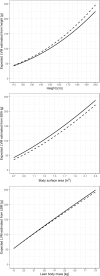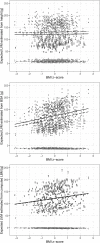Left ventricular mass is underestimated in overweight children because of incorrect body size variable chosen for normalization
- PMID: 31141818
- PMCID: PMC6541472
- DOI: 10.1371/journal.pone.0217637
Left ventricular mass is underestimated in overweight children because of incorrect body size variable chosen for normalization
Abstract
Background: Left ventricular mass normalization for body size is recommended, but a question remains: what is the best body size variable for this normalization-body surface area, height or lean body mass computed based on a predictive equation? Since body surface area and computed lean body mass are derivatives of body mass, normalizing for them may result in underestimation of left ventricular mass in overweight children. The aim of this study is to indicate which of the body size variables normalize left ventricular mass without underestimating it in overweight children.
Methods: Left ventricular mass assessed by echocardiography, height and body mass were collected for 464 healthy boys, 5-18 years old. Lean body mass and body surface area were calculated. Left ventricular mass z-scores computed based on reference data, developed for height, body surface area and lean body mass, were compared between overweight and non-overweight children. The next step was a comparison of paired samples of expected left ventricular mass, estimated for each normalizing variable based on two allometric equations-the first developed for overweight children, the second for children of normal body mass.
Results: The mean of left ventricular mass z-scores is higher in overweight children compared to non-overweight children for normative data based on height (0.36 vs. 0.00) and lower for normative data based on body surface area (-0.64 vs. 0.00). Left ventricular mass estimated normalizing for height, based on the equation for overweight children, is higher in overweight children (128.12 vs. 118.40); however, masses estimated normalizing for body surface area and lean body mass, based on equations for overweight children, are lower in overweight children (109.71 vs. 122.08 and 118.46 vs. 120.56, respectively).
Conclusion: Normalization for body surface area and for computed lean body mass, but not for height, underestimates left ventricular mass in overweight children.
Conflict of interest statement
The authors have declared that no competing interests exist.
Figures


Similar articles
-
Height Versus Body Surface Area to Normalize Cardiovascular Measurements in Children Using the Pediatric Heart Network Echocardiographic Z-Score Database.Pediatr Cardiol. 2021 Aug;42(6):1284-1292. doi: 10.1007/s00246-021-02609-x. Epub 2021 Apr 20. Pediatr Cardiol. 2021. PMID: 33877418 Free PMC article.
-
Left ventricular mass and body size in normotensive children and adults: assessment of allometric relations and impact of overweight.J Am Coll Cardiol. 1992 Nov 1;20(5):1251-60. doi: 10.1016/0735-1097(92)90385-z. J Am Coll Cardiol. 1992. PMID: 1401629
-
Limitations of expressing left ventricular mass relative to height and to body surface area in children.J Am Soc Echocardiogr. 2013 Apr;26(4):410-8. doi: 10.1016/j.echo.2012.11.018. Epub 2012 Dec 23. J Am Soc Echocardiogr. 2013. PMID: 23267782
-
Lean body mass is the strongest anthropometric predictor of left ventricular mass in the obese paediatric population.Cardiol Young. 2020 Apr;30(4):476-481. doi: 10.1017/S1047951120000311. Epub 2020 Mar 16. Cardiol Young. 2020. PMID: 32172704 Free PMC article.
-
Impact and pitfalls of scaling of left ventricular and atrial structure in population-based studies.J Hypertens. 2016 Jun;34(6):1186-94. doi: 10.1097/HJH.0000000000000922. J Hypertens. 2016. PMID: 27035735
Cited by
-
Height Versus Body Surface Area to Normalize Cardiovascular Measurements in Children Using the Pediatric Heart Network Echocardiographic Z-Score Database.Pediatr Cardiol. 2021 Aug;42(6):1284-1292. doi: 10.1007/s00246-021-02609-x. Epub 2021 Apr 20. Pediatr Cardiol. 2021. PMID: 33877418 Free PMC article.
-
Cardiac Magnetic Resonance Derived Left Ventricular Eccentricity Index and Right Ventricular Mass Measurements Predict Outcome in Children with Pulmonary Arterial Hypertension.Children (Basel). 2023 Apr 21;10(4):756. doi: 10.3390/children10040756. Children (Basel). 2023. PMID: 37190005 Free PMC article.
-
Left ventricular mass normalization for body size in children based on an allometrically adjusted ratio is as accurate as normalization based on the centile curves method.PLoS One. 2019 Nov 21;14(11):e0225287. doi: 10.1371/journal.pone.0225287. eCollection 2019. PLoS One. 2019. PMID: 31751386 Free PMC article.
-
Left ventricular mass normalization in child and adolescent athletes must account for sex differences.PLoS One. 2020 Jul 27;15(7):e0236632. doi: 10.1371/journal.pone.0236632. eCollection 2020. PLoS One. 2020. PMID: 32716972 Free PMC article.
-
Defining left ventricular remodeling using lean body mass allometry: a UK Biobank study.Eur J Appl Physiol. 2023 May;123(5):989-1001. doi: 10.1007/s00421-022-05125-9. Epub 2023 Jan 8. Eur J Appl Physiol. 2023. PMID: 36617359
References
-
- Daniels SR, Kimball TR, Morrison JA, Khoury P, Witt S, Meyer RA. Effect of lean body mass, fat mass, blood pressure, and sexual maturation on left ventricular mass in children and adolescents. Statistical, biological, and clinical significance. Circulation 1995: 92: 3249–3254. - PubMed
-
- de Simone G, Devereux RB, Daniels SR, Koren MJ, Meyer RA, Laragh JH. Effect of growth on variability of left ventricular mass: assessment of allometric signals in adults and children and their capacity to predict cardiovascular risk. J Am Coll Cardiol 1995; 25: 1056–62. - PubMed
MeSH terms
Substances
LinkOut - more resources
Full Text Sources
Medical

